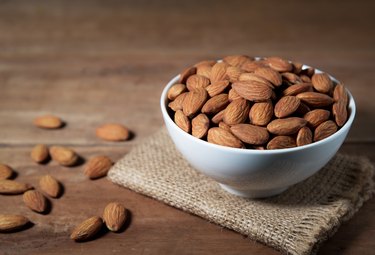
Almond flour, almond powder and almond meal are all essentially the same thing – ground almonds with zero other ingredients. Almond flour, the finest type of ground almonds, is a key ingredient in macarons and other baked goods and is a popular gluten-free alternative to wheat flour. Almond meal, which is coarser in texture, makes a delicious crunchy coating for baked and fried savory foods as well as a topping for casseroles and similar dishes.
Both are readily available in most supermarkets but can be pricey. Making your own ground almonds is a cheaper alternative and is easy to do if you have the right equipment, namely a food processor or high-powered blender.
Video of the Day
Video of the Day
Making Almond Flour vs. Almond Meal
Making almond flour is a little more involved than making almond meal because it requires the almonds to be skinned. It also requires a longer processing time than is necessary for almond meal, as the flour needs to be as fine as possible. This means there's a greater risk of overprocessing the flour, which can make it clumpy.
If you want to make almond meal, you have the option to start with slivered, sliced or chopped almonds instead of whole ones, as the small amounts of skin attached to these kinds of almonds is not a problem. You can also start with whole almonds and choose whether or not to skin them. The coarser grind of almond meal is quicker and easier to achieve, even with a lower-powered food processor. For small batches of almond meal, you might use a mini food processor or even a coffee grinder.
How to Make Almond Flour
To make almond flour, start with whole, unsalted, unroasted almonds. Blanch the almonds by adding them to a pot of boiling water, letting them sit for a minute and then draining and rinsing under cold water. Alternatively, put the almonds in a bowl, cover them with just-boiled water and let them sit for a few minutes before draining. After blanching and rinsing, you should be able to slip the almonds out of their skins easily. Discard the skins.
It's essential to fully dry the skinned almonds before grinding them. If you try to process the almonds while they're damp, there's a good chance you will end up with almond butter instead of flour. Spread out the skinned almonds on a baking sheet and place them in a 350-degree oven for 10 to 15 minutes, pulling them out before they turn brown.
Chop the almonds roughly with a knife before adding them to a food processor or high-powered blender in small batches of no more than half a cup at a time. Pulse the almonds and keep a constant eye on them to make sure you don't get any clumps. Pulse repeatedly until the almonds are ground to a fine powder. Sift the powder for an even finer almond flour.
How to Make Almond Meal
Make almond meal following the same process as that for almond flour but stop processing the almonds when they are similar in consistency to sand. You can also opt to skip the blanching and skinning steps if you don't mind having small flecks of skin in the almond meal. For almond meal, you can also choose to start with slivered, sliced or chopped almonds, although they should always be unsalted and unroasted.
Ground Almond Tips
- For a recipe that calls for almond flour or meal by weight, you can start with the same weight of almonds before processing. If your recipe uses volume measurements, know that you'll get approximately 1 pound of ground almonds from 2 2/3 cups of whole almonds.
- Ground almonds do not generally impart a noticeable almond flavor to baked goods or other dishes. If you want to amplify the flavor of the almonds, toast them in the oven or a hot skillet before grinding.
- To reduce the risk of overprocessing almonds, which can create clumps and eventually turn them into almond butter, chill the almonds and food processor blade in the freezer for 30 minutes or so before grinding.
- If you're not going to use your ground almonds immediately, store them in a sealed container in the freezer. Ground almonds will otherwise spoil quickly.